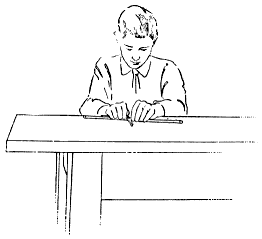evaporates first and leaves the water in the wick. Then when you try
to light the wick again, you will find that you cannot do so, because,
of course, water does not burn. If this happens to you, take the wick
out, dry it, and start the lamp again.

FIG. 6
MATCHING A SCRATCH
|
It is perfectly safe to use kerosene in the
lamp, but it gives a very smoky flame which deposits soot on the glass
and fills the air with soot particles. Your mother will object very
strenuously to this because the soot particles settle and blacken
everything. Burn alcohol only, at least in the house.
Experiment 2. To cut glass tubing.
Cut off a six inch length of No. 2 as follows:
Lay the tube flat on the table, mark the six-inch length and draw the
file across the tube at this point, pressing hard enough to make a good

FIG. 7
BREAKING THE TUBE
|
scratch (Fig. 6). Grasp the tube with both hands near the scratch,
as in Fig. 7, pull apart and bend slightly. Do you find that the tube
breaks across easily?
Repeat this with No. 4 and No. 6 tubes.
|